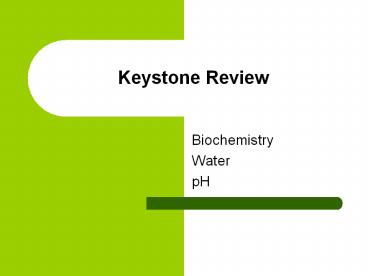Keystone Review - PowerPoint PPT Presentation
1 / 28
Title:
Keystone Review
Description:
Keystone Review Biochemistry Water pH * Carbon Carbon can form lots of bonds (and shapes) because it has four electrons in its outer energy level Carbon variety ... – PowerPoint PPT presentation
Number of Views:76
Avg rating:3.0/5.0
Title: Keystone Review
1
Keystone Review
- Biochemistry
- Water
- pH
2
Carbon
- Carbon can form lots of bonds (and shapes)
because it has four electrons in its outer energy
level
3
Carbon variety
Branched chain
4
Covalent bondSHARING
5
Carbon double bond and triple bond
6
Macromolecules of Life
- Living things rely on 4 macromolecules
- CARBOHYDRATES
- LIPIDS
- PROTEINS
- NULCEIC ACIDS
- Each macromolecule is made up of smaller building
blocks called monomers. (mono means one. A
macromolecule is a polymer (poly means many)
7
Macromolecule (Polymer) Building Block (Monomer)
Carbohydrate Monosaccharide
Lipid Fatty Acid
Protein Amino Acid
Nucleic Acid Nucleotide
8
Monomer and Polymer
9
Monomers are like legos
- You can put them together in whatever way you
dream up!
10
Condensation reaction AKA Dehydration synthesis
11
Carbohydrate
- Used for short term energy in the body
12
Carbohydrate polymers
13
Cellulose a carbohydrate used for structure
14
Glycogen use and storage
15
Lipids Long term energy storage
16
Cell membrane phospholipids
17
Lipids
- Can also insulate the body
18
Protein
- THREE JOBS
- Provide structurehair
- Supportmuscles
- Speed up reactions
19
Catalyst (type of protein)
- Speeds up chemical reactions without being
consumed
20
Enzyme
21
pH changes enzymes
22
Temperature changes enzymes
23
Concentration
The amount of substrate limits the activity of
the enzyme
24
Nucleic Acid
- Nucleic acids hold information in code
- There are 2 types DNA and RNA
25
Nucelic acid
26
Building block
- Nucleic acids are made up of building blocks
called NUCLEOTIDES.
27
DNA
- DNA is always found in the NUCLEUS, or center of
the cell (in prokaryotes). - DNA is in the shape of a DOUBLE HELIX.
28
RNA
- RNA can travel throughout the cell, because it
carries INFORMATION on how to make PROTEIN and
other vital cell parts. - RNA is generally a SINGLE STRAND.
29
Water
- Polar molecule
- Oxygen hydrogen share electrons but not equally
30
Why is water sticky
- Hydrogen bonds
- The slight negative end and slight positive end
of each water sticks to each other
31
Properties of water
- Polarity
- Cohesion
- Surface tension
- Capillary action
- Adhesion
- Universal solvent
- High specific heat
- Less dense as a solid
32
pH scale
- Runs from 0 to 14
- Below 7 is acidic
- 7 is neutral
- Above 7 is basic
- Measures the amount of hydrogen ions (H) in a
solution

